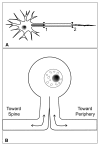Carpal tunnel syndrome and the "double crush" hypothesis: a review and implications for chiropractic
- PMID: 18426564
- PMCID: PMC2365954
- DOI: 10.1186/1746-1340-16-2
Carpal tunnel syndrome and the "double crush" hypothesis: a review and implications for chiropractic
Abstract
Upton and McComas claimed that most patients with carpal tunnel syndrome not only have compressive lesions at the wrist, but also show evidence of damage to cervical nerve roots. This "double crush" hypothesis has gained some popularity among chiropractors because it seems to provide a rationale for adjusting the cervical spine in treating carpal tunnel syndrome. Here I examine use of the concept by chiropractors, summarize findings from the literature, and critique several studies aimed at supporting or refuting the hypothesis. Although the hypothesis also has been applied to nerve compressions other than those leading to carpal tunnel syndrome, this discussion mainly examines the original application - "double crush" involving both cervical spinal nerve roots and the carpal tunnel. I consider several categories: experiments to create double crush syndrome in animals, case reports, literature reviews, and alternatives to the original hypothesis. A significant percentage of patients with carpal tunnel syndrome also have neck pain or cervical nerve root compression, but the relationship has not been definitively explained. The original hypothesis remains controversial and is probably not valid, at least for sensory disturbances, in carpal tunnel syndrome. However, even if the original hypothesis is importantly flawed, evaluation of multiple sites still may be valuable. The chiropractic profession should develop theoretical models to relate cervical dysfunction to carpal tunnel syndrome, and might incorporate some alternatives to the original hypothesis. I intend this review as a starting point for practitioners, educators, and students wishing to advance chiropractic concepts in this area.
Figures

Similar articles
-
Double crush syndrome: chiropractic care of an entrapment neuropathy.J Manipulative Physiol Ther. 1991 May;14(4):262-5. J Manipulative Physiol Ther. 1991. PMID: 2066684
-
The double crush syndrome.Orthop Clin North Am. 1988 Jan;19(1):147-55. Orthop Clin North Am. 1988. PMID: 3275922 Review.
-
Outcomes following Peripheral Nerve Decompression with and without Associated Double Crush Syndrome: A Case Control Study.Plast Reconstr Surg. 2017 Jan;139(1):119-127. doi: 10.1097/PRS.0000000000002863. Plast Reconstr Surg. 2017. PMID: 27627055
-
[Clinical study of cervical myeloradiculopathy with carpal tunnel syndrome, double crush syndrome].No To Shinkei. 2005 Oct;57(10):883-7. No To Shinkei. 2005. PMID: 16277233 Japanese.
-
Double Crush Syndrome.J Am Acad Orthop Surg. 2015 Sep;23(9):558-62. doi: 10.5435/JAAOS-D-14-00176. J Am Acad Orthop Surg. 2015. PMID: 26306807 Review.
Cited by
-
Pathophysiology of carpal tunnel syndrome.Neurosciences (Riyadh). 2015 Jan;20(1):4-9. Neurosciences (Riyadh). 2015. PMID: 25630774 Free PMC article. Review.
-
Current Insights into Carpal Tunnel Syndrome: Clinical Strategies for Prevention and Treatment.Curr Drug Targets. 2024;25(4):221-240. doi: 10.2174/0113894501280331240213063333. Curr Drug Targets. 2024. PMID: 38385490 Review.
-
Central sensitization does not identify patients with carpal tunnel syndrome who are likely to achieve short-term success with physical therapy.Exp Brain Res. 2010 Nov;207(1-2):85-94. doi: 10.1007/s00221-010-2436-7. Epub 2010 Oct 16. Exp Brain Res. 2010. PMID: 20953591
-
The Relationship between Nerve Conduction Study and Clinical Grading of Carpal Tunnel Syndrome.J Clin Diagn Res. 2016 Jul;10(7):OC13-8. doi: 10.7860/JCDR/2016/20607.8097. Epub 2016 Jul 1. J Clin Diagn Res. 2016. PMID: 27630881 Free PMC article.
-
Effects of 1-hour computer use on ulnar and median nerve conduction velocity and muscle activity in office workers.J Occup Health. 2024 Jan 4;66(1):uiae023. doi: 10.1093/joccuh/uiae023. J Occup Health. 2024. PMID: 38710168 Free PMC article.
References
-
- Swenson RS. Double crush syndrome: what is the evidence? J Neuromusculoskeletal System. 1993;1:23–29.
-
- Horizon Health Care Group http://www.horizonhealthcaregroup.com/health.html
-
- New Life Chiropractic Clinic http://www.drharvey.com/articles_carpeltunnel.htm
-
- American Family Chiropractic Center http://www.drhakes.com/injuries.html
LinkOut - more resources
Full Text Sources

